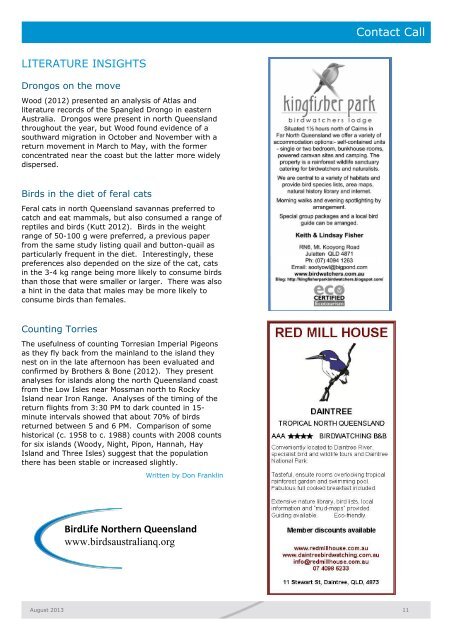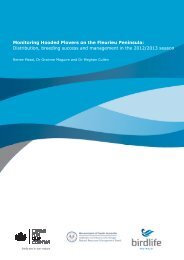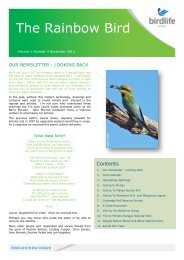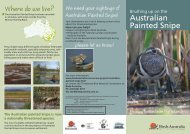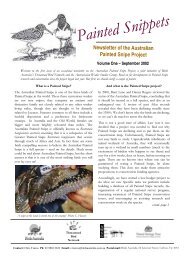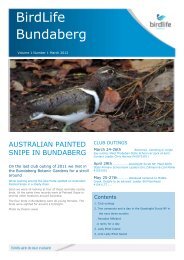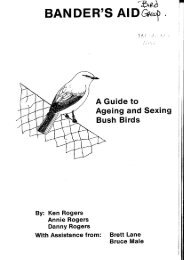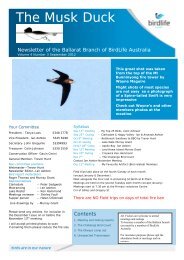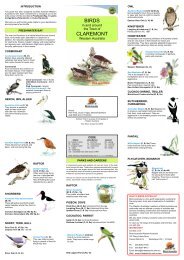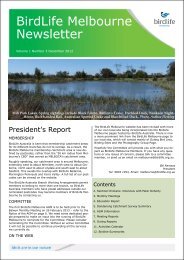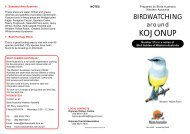Birdlife Northern QueenslandResearch:Recent (2012)literature about birds inNorth QueenslandNon-technicalChaplin D. 2012. Into the unknown. <strong>Australia</strong>n Birdlife1(4): 40-41. [Fawn-breasted Bowerbird]Eussen D. 2012. <strong>Birds</strong> of the tidal forest. <strong>Australia</strong>nBirdlife 1(2): 52-55.Maurer G. 2012. Shorebirds of the savannah.<strong>Australia</strong>n Birdlife 1(3): 42-47. [Oriental Pratincole,Little Curlew, Oriental Plover]Tarburton M 2012. Swift manoeuvres: how nesting<strong>Australia</strong>n Swiftlets beat La Nina floodings. <strong>Australia</strong>nBirdlife 1(3): 26-29. [Chillagoe]<strong>Birds</strong> of rainforest and wet sclerophyllforestAnderson AS, Reside AE, VanDerWal JJ, Shoo LP,Pearson RG, Williams SE. 2012. Immigrants andrefugees: the importance of dispersal in mediatingbiotic attrition under climate change. Global ChangeBiology 18: 2126-2134.Brothers N, Bone C. 2012. Torresian Imperial PigeonDucula spilorrhoa monitoring, population trends andspecies suitability as an indicator of environmentalchange. Corella 36: 69-75.Catterall CP, Freeman AND, Kanowski J, Freebody K.2012. Can active restoration of tropical rainforestrescue biodiversity? A case with bird communityindicators. Biological Conservation 146: 53-61.Chapman A, Kofron CP. 2012. Non-resident birds intropical wet sclerophyll forest, northeast Queensland,<strong>Australia</strong>. Tropical Zoology 25: 127-134.Savanna birdsKutt AS. 2012. Feral cat (Felis catus) prey size andselectivity in north-eastern <strong>Australia</strong>: implications formammal conservation. Journal of Zoology 287: 292-300.Kutt AS, Perkins GC, Colman N, Vanderduys EP, PerryJJ. 2012. Temporal variation in a savanna birdassemblage: what changes over 5 years? Emu 112:32-38.Kutt AS, Vanderduys EP, Ferguson D, Mathieson M.2012. Effect of small-scale woodland clearing andthinning on vertebrate fauna in a largely intact tropicalsavanna mosaic. Wildlife Research 39: 366-373.Kutt AS, Vanderduys EP, O'Reagain P. 2012. Spatialand temporal effects of grazing management andrainfall on the vertebrate fauna of a tropical savanna.Rangeland Journal 34: 173-182.Kutt AS, Vanderduys EP, Perry JJ, Perkins GC. 2012.Do miners (Manorina spp.) affect bird assemblages incontinuous savanna woodlands in north-eastern<strong>Australia</strong>? Austral Ecology 37: 779-788.Kutt AS, Vanderduys EP, Perry JJ, Perkins GC, KempJE, Bateman BL, Kanowski J, Jensen R. 2012. Signalsof change in tropical savanna woodland vertebratefauna 5 years after cessation of livestock grazing.Wildlife Research 39: 386-396.Perry JJ, Kutt AS, Perkins GC, Vanderduys EP, ColmanNJ. 2012. A bird survey method for <strong>Australia</strong>n tropicalsavannas. Emu 112: 261-266.Reside AE, VanDerWal J, Kutt A, Watson I, Williams S.2012. Fire regime shifts affect bird speciesdistributions. Diversity and Distributions 18: 213-225.Valentine LE, Schwarzkopf L, Johnson CN. 2012.Effects of a short fire-return interval on resources andassemblage structure of birds in a tropical savanna.Austral Ecology 37: 23-34.Vanderduys EP, Kutt AS, Kemp JE. 2012. Uplandsavannas: the vertebrate fauna of largely unknown butsignificant habitat in north-eastern Queensland.<strong>Australia</strong>n Zoologist 36: 59-74.Vanderduys EP, Kutt AS, Perry JJ, C PG. 2012. Thecomposition of mixed-species bird flocks in northern<strong>Australia</strong>n savannas. Emu 112: 218-226.Waterbirds & miscellaniaHoque MA, Burgess GW, Karo-Karo D, Cheam AL,Skerratt LF. 2012. Monitoring of wild birds forNewcastle disease virus in north Queensland,<strong>Australia</strong>. Preventive Veterinary Medicine 103: 49-62.Wood KA. 2012. An analysis of the movements of theSpangled Drongo in eastern <strong>Australia</strong> (late 1800s-mid1990s). <strong>Australia</strong>n Field Ornithology 29: 113-132.Compiled by Don Franklin10 August 2013
<strong>Contact</strong> <strong>Call</strong>LITERATURE INSIGHTSDrongos on the moveWood (2012) presented an analysis of Atlas andliterature records of the Spangled Drongo in eastern<strong>Australia</strong>. Drongos were present in north Queenslandthroughout the year, but Wood found evidence of asouthward migration in October and November with areturn movement in March to May, with the formerconcentrated near the coast but the latter more widelydispersed.<strong>Birds</strong> in the diet of feral catsFeral cats in north Queensland savannas preferred tocatch and eat mammals, but also consumed a range ofreptiles and birds (Kutt 2012). <strong>Birds</strong> in the weightrange of 50-100 g were preferred, a previous paperfrom the same study listing quail and button-quail asparticularly frequent in the diet. Interestingly, thesepreferences also depended on the size of the cat, catsin the 3-4 kg range being more likely to consume birdsthan those that were smaller or larger. There was alsoa hint in the data that males may be more likely toconsume birds than females.Counting TorriesThe usefulness of counting Torresian Imperial Pigeonsas they fly back from the mainland to the island theynest on in the late afternoon has been evaluated andconfirmed by Brothers & Bone (2012). They presentanalyses for islands along the north Queensland coastfrom the Low Isles near Mossman north to RockyIsland near Iron Range. Analyses of the timing of thereturn flights from 3:30 PM to dark counted in 15-minute intervals showed that about 70% of birdsreturned between 5 and 6 PM. Comparison of somehistorical (c. 1958 to c. 1988) counts with 2008 countsfor six islands (Woody, Night, Pipon, Hannah, HayIsland and Three Isles) suggest that the populationthere has been stable or increased slightly.Written by Don FranklinBirdLife Northern Queenslandwww.birdsaustralianq.orgAugust 2013 11


